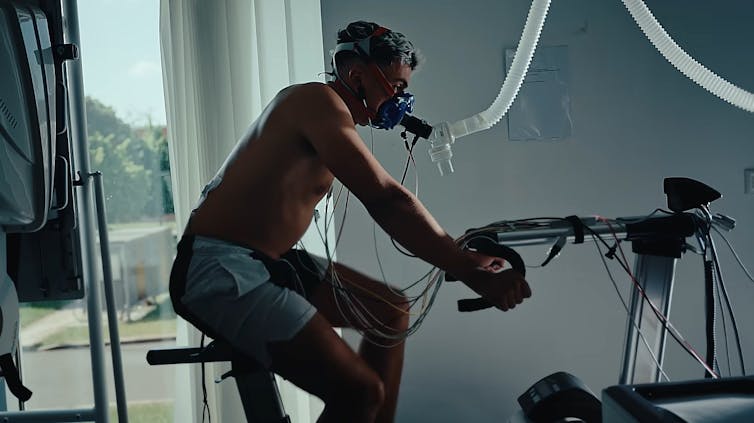
The documentary Kaizen, by French YouTuber Inoxtag, which chronicles the year he spent preparing to climb Mount Everest, got many mostly positive reactions. However, there is also good reason to wonder whether there is something harmful in the way he promotes the value of self-improvement — which he applies to himself in the documentary — to the teenaged members of his community.
A majority of his 20 million subscribers congratulated the young YouTuber for accomplishing his goal. In doing so, they recognized him as a true “cultural trendsetter.”
Others were more critical. While acknowledging his dazzling entrepreneurial success, they pointed out the way he instrumentalizes certain values, such as sports, to support a meritocratic discourse. Still others criticized him for selling “the idea of limitless resources when there is an environmental imperative to practise sobriety.”
As a professor and specialist in intervention and organizational communication at the Université du Québec à Montréal, I’d like to take this opportunity to discuss the dangerous new way that self-improvement or continuous improvement — also known as “kaizen,” an organizational performance improvement practice — is being promoted as a lifestyle.
A major project
Inoxtag draws on his enormous influence to convey this message. His digital platforms together have over 20 million subscribers. Among these, his YouTube channel is the largest, with 8.66 million subscribers.
His recent documentary, Kaizen: 1 Year to Climb Everest is very appealing. Aimed at an audience of mostly young teenagers, the documentary conveys a positive message of self-improvement.

Material, human and financial resources are also part of the story. In addition to documenting every stage of his adventure, Inoxtag climbed Everest with his friends, each of whose presence cost him more than $75,000.
The editing is meticulous and the images are breathtaking. The moments of introspection are spontaneous and sincere and the advertising insertions are subtle, but effective. In short, the documentary has all the ingredients to make it both fascinating and inspiring.
Kaizen: a truncated definition
The two hour 26-minute documentary is called Kaizen. However, we only learn the definition of the term at the very end.
This Japanese word, composed of kai, meaning “change,” and zen, meaning “for the better” or “the best,” has been used since the 1950s to describe a process of continuous improvement in management. It refers to the desire to strategically improve production excellence in ultra-competitive environments.
Although this process initially concerned the post-war manufacturing sector, it gradually spread to other sectors, including the services industry and the civil service. The term has been misused since then to designate an attitude that makes performance, itself, an unattainable goal.
The instrumentalization of ‘Kaizen’
Kaizen, as a practice for improving organizational performance, is above all an attempt to eliminate waste. In so doing, it fits in with the management philosophy known as Lean, which consists of “always doing more with less.” Kaizen invites organizational employees to understand how a situation could be improved, to come up with ideas for improvement, to contribute to the development of solutions, and then to put these into practice.
However, the expression “continuous improvement” is meant to serve the interests of the organization, not the people who put it into action (typically the organization’s employees). In the case of Inoxtag, continuous improvement works on two levels. Firstly, it benefits him, as a mantra that he periodically repeats to his community. Secondly, albeit more subtly, the expression serves the YouTuber’s commercial partners, who gain visibility and generate publicity by supporting his adventure.
We are thus witnessing an aestheticization of total performance, the new spirit of capitalism.
The body as a stage for continuous improvement
Worse still, the body, through the physical activity of surpassing its limits, becomes, itself, the object of continuous improvement. Directing the body as it suffers to improve itself enough to climb Mount Everest aestheticizes continuous improvement, making it desirable.
In addition to being powerfully and socially internalized and prescribed as “positive” (who doesn’t want to improve?), it seems to me that in these conditions, continuous improvement is likely to become an insatiable quest that only brings suffering and exhaustion. After all, you can only do as much as your body can do.

It also refers to the sole responsibility of the individual, deliberately ignoring all material, relational and social dimensions. To what extent do the material conditions of existence allow a person to take on any challenge, or to initiate any “project?” Is it even possible to set these kinds of goals without a solid support system (parents, mentors, friends and other significant resources)?
Questioning continuous improvement
In his documentary, Inoxtag says things that are directly related to continuous improvement, such as “I want to be a new man,” and “every day better than yesterday.” In portraying continuous improvement as irrefutable and by elevating it to the status of a new anthropological reality, we run the risk of turning hyperperformance into an existential goal, without questioning whether it even makes sense.
I understand that we can be positively affected by this type of message and by the values it claims to embody, such as courage, perseverance and surpassing one’s limits. I can also understand the physical pleasure that comes from putting these values into action.
However, behind this craze for continuous self-improvement, we can also see the toxic effects of a capitalist structure that valorizes and validates this craze (at social, organizational and individual levels) to the point of exhaustion, until the body can’t take it any more.
We must therefore radically question this “false evidence,” and forcefully reaffirm that surpassing your limits through continuous improvement is, more than anything, the symptom of silent and destructive individual pleasure that morally enslaves, more than it emancipates — even if its flashy appearance is fun to watch, or even imitate.
Thomas Maxwell ne travaille pas, ne conseille pas, ne possède pas de parts, ne reçoit pas de fonds d'une organisation qui pourrait tirer profit de cet article, et n'a déclaré aucune autre affiliation que son organisme de recherche.
This article was originally published on The Conversation. Read the original article.







